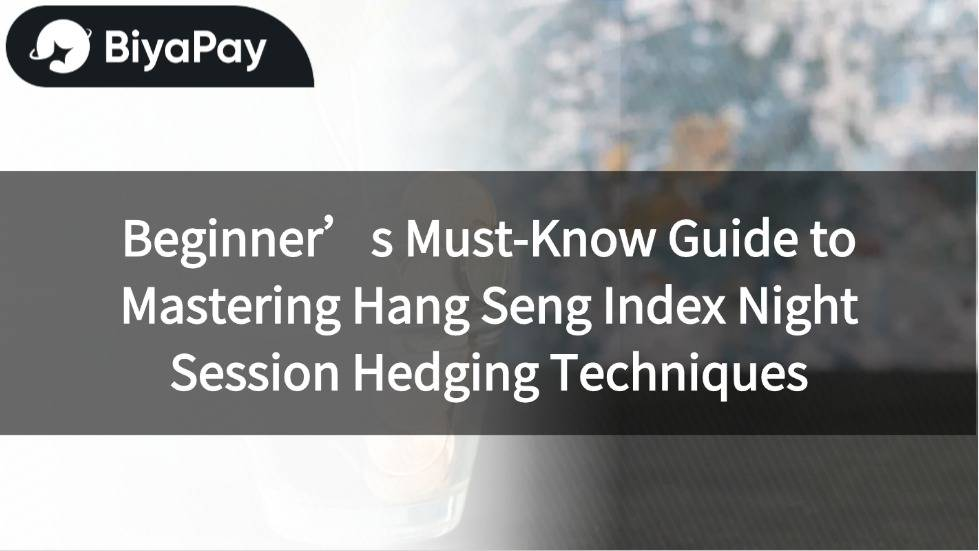- EasyCard
- Trade
- Help
- Announcement
- Academy
- SWIFT Code
- Iban Number
- Referral
- Customer Service
- Blog
- Creator
Beginner’s Must-Know Guide to Mastering Hang Seng Index Night Session Hedging Techniques

Image Source: unsplash
If you want to effectively hedge in the Hang Seng Index night session, you must master several key steps.
First, you need to know how to choose the right timing and observe market trends.
You can use futures or options as hedging tools.
Remember, setting stop-loss levels helps reduce losses.
The night session is more volatile, so you need to pay special attention to risk management to ensure every operation is clear and orderly.
Key Points
- The Hang Seng Index night session is the evening trading period for Hang Seng Index futures and options, allowing you to respond instantly to global market news and enhance investment flexibility.
- Using futures and options as hedging tools can effectively reduce risks caused by international market volatility, protecting your investment portfolio.
- Choosing the right entry and exit timing and setting stop-loss and take-profit levels are key steps to improving hedging success rates and controlling losses.
- Strictly executing operational processes and risk management, avoiding emotional influences on judgment, can help you maintain stable performance in night session trading.
- Combining technical analysis, data tracking, and automated tools, along with continuous learning and strategy review, can improve the efficiency and effectiveness of night session hedging.
Hang Seng Index Night Session Basics

Image Source: pexels
What is the Hang Seng Index Night Session?
You need to know that the Hang Seng Index night session is the evening trading period for Hang Seng Index futures and options.
The night session generally runs from 5:15 PM to 3:00 AM.
This period differs from the daytime regular session, allowing you to adjust your investment portfolio in response to global market news.
Tip: During the night session, European and American markets are open, and international news significantly impacts the Hang Seng Index night session.
You can buy or sell Hang Seng Index futures or options during the night session to flexibly respond to sudden events.
The establishment of the night session allows you to react without waiting until the next morning, which is crucial for risk management.
Role of Night Session Hedging
When you hedge in the night session, the main purpose is to reduce risks caused by international market volatility.
Although liquidity in the night session is lower than in the day session, you can still use futures or options to quickly adjust positions.
- You can use futures in the night session to hedge spot holdings, reducing losses from unexpected news.
- You can also use options strategies to lock in potential profits or limit maximum losses.
Price volatility in the night session is higher, but the settlement mechanism is the same as the day session.
You should note that the night session has lower trading volume, and the bid-ask spread may be wider.
You should closely monitor international market news, especially economic data releases from the US and China, as these directly affect the Hang Seng Index night session’s trends.
Hedging Techniques

Image Source: pexels
Timing Selection
To hedge in the Hang Seng Index night session, you first need to learn to choose the right timing.
The correct entry and exit timing can significantly enhance your hedging effectiveness.
You can refer to the following market data to make judgments:
- Observe the price correlation between different commodities or sectors to judge market trends.
- Compare the strength and weakness of sectors to identify the best entry and exit timing.
- Pay attention to price divergence and convergence phenomena, which help you predict price reversals or trend continuations.
- Use technical indicators and chart analysis to assist in decision-making.
- Refer to statistical analysis methods to improve the precision of hedging operations.
- Be cautious before entering a position, and execute exits and stop-losses decisively to avoid emotional influences on judgment.
Tip: Based on historical data of US stock volatility, avoiding the worst periods and choosing the best entry timing can result in an 80% difference in returns. You can refer to indicators like unemployment rates, inflation, and yield curves to judge market cycles and improve hedging success rates.
Strategy Application
In the Hang Seng Index night session, you can use various hedging tools.
The most common are futures and options.
You can choose different strategies based on market volatility:
- Futures: You can use Hang Seng Index futures to hedge spot holdings, which is effective when you expect significant volatility in the night session to quickly adjust risks.
- Options: You can buy put options to limit maximum losses or sell call options to lock in potential profits.
You can also refer to international market volatility indices, such as the Chicago Board Options Exchange’s S&P 500 Three-Month Volatility Index, which can help you gauge market sentiment.
The volatility index has an inverse relationship with the S&P 500 index; when volatility rises, market risks typically increase.
You can use these indicators, combined with calendar spread trading or spread strategies, to enhance hedging effectiveness.
Note: Liquidity in the night session is lower, and bid-ask spreads may be wider. You should pay special attention to trading volume and price jumps to avoid additional risks due to insufficient liquidity.
Operational Steps
To hedge in the Hang Seng Index night session, it is recommended to follow these steps:
- First, set a hedging goal, such as protecting spot holdings or locking in profits.
- Analyze market conditions and choose the appropriate hedging tool (futures or options).
- Decide entry and exit timing based on technical indicators and statistical data.
- Set stop-loss and take-profit levels and strictly adhere to operational discipline.
- Monitor market changes continuously after trading and adjust positions promptly.
- After completing the trade, check all data to ensure every transaction is accurate. You can use sample data validation, subset data validation, or full dataset validation to ensure the operation process is error-free.
- Regularly review operational processes and use automated tools to improve efficiency and accuracy.
Tip: You can use automated tools (such as ETL tools) to enhance data processing efficiency, reduce human errors, and ensure every operation is validated.
As long as you follow these steps systematically and execute each process strictly, you can effectively hedge in the Hang Seng Index night session and reduce risks from market volatility.
Risk Management
Stop-Loss and Take-Profit
When operating in the Hang Seng Index night session, you must learn to set stop-loss and take-profit levels.
Stop-loss helps you limit losses, while take-profit locks in profits.
You should set stop-loss and take-profit levels in advance based on your risk tolerance.
For example, you can set the stop-loss at 2% to 3% below the entry price and the take-profit at 5% to 8% above.
This way, even if the market suddenly fluctuates, you can automatically close positions, avoiding emotional influences on judgment.
Tip: You can use the trading platform’s automatic stop-loss function to reduce human errors and improve execution efficiency.
Common Mistakes
When hedging in the night session, common mistakes include neglecting risk management, over-leveraging, and lax operational processes.
Taking electronic trading as an example, inadequate cable certification is a high-risk error.
Damaged or improperly installed cables can lead to on-site downtime, with average losses of up to $260,000 per hour (approximately HKD 2,028,000 at 1 USD = 7.8 HKD).
This shows that neglecting details can lead to significant losses.
You should regularly check equipment and operational processes to ensure every step meets standards.
Risk Control
To effectively control risks, you can adopt the following methods:
- Strictly execute stop-loss and take-profit strategies.
- Control the capital proportion for each trade to avoid excessive losses from a single transaction.
- Regularly review trading records to identify areas for improvement.
- Monitor liquidity changes in the night session and avoid large trades during extremely low liquidity periods.
As long as you develop good risk management habits, you can significantly reduce potential risks in night session hedging and improve long-term investment performance.
Real-World Case Studies
Success Case
You can refer to the following successful case of hedging in the Hang Seng Index night session.
An investor used futures to hedge before the US announced significant economic data.
Based on technical analysis and market data, they set stop-loss and take-profit levels in advance.
This operation not only successfully avoided sharp fluctuations in the night session but also locked in profits.
You can see the key factors for success from the data:
- Brand Exposure Rate: The investor shared their trading experience on social platforms, with a high ratio of impressions to reach, attracting more attention.
- Traffic Diversion: Using automated systems to track night session trading data significantly increased website traffic.
- Engagement Rate: The operation process garnered numerous comments and discussions, indicating high market participation.
| Indicator Type | Specific Indicator | Description |
|---|---|---|
| Activity Indicator | Number of Trades | Reflects market participation |
| Outcome Indicator | Return on Investment (ROI) | Measures overall effectiveness |
| Quality Indicator | Trade Success Rate | Directly reflects hedging effectiveness |
Tip: You can combine technical analysis, data tracking, and automated tools to improve the success rate of night session hedging.
Lessons from Failure
You should also understand failure cases to avoid repeating mistakes.
An investor, influenced by emotional fluctuations, ignored market data and misjudged the night session trend.
They failed to adjust strategies based on macroeconomic data and corporate financial reports, resulting in significant losses during sharp night session volatility.
Market sentiment, especially collective anxiety, can affect your judgment.
Psychological studies show that group anxiety can lead to erroneous decisions, harming investment returns.
You should rely on objective data, such as export values and economic indicators, to judge market trends and reduce emotional interference.
You can examine the reasons for failure in the following stages:
- Requirement Stage: Failure to accurately judge market demand led to incorrect entry.
- Design Stage: Neglecting risk management resulted in flawed design.
- Data Stage: Poor data quality affected decision-making.
- Deployment Stage: Failure to adjust strategies in time amplified losses.
Remember: You must stay rational and operate based on data to reduce mistakes in night session hedging.
To master Hang Seng Index night session hedging, you must remember that every operation should have a clear goal.
You can start with small amounts and record insights from each operation.
Regularly review strategies and make immediate adjustments when deficiencies are found.
Recommendation: Refer to market data frequently, continue learning risk management, and improve hedging skills.
FAQ
Is there a minimum capital requirement for Hang Seng Index night session hedging?
You can start night session hedging with a small amount of capital.
Some Hong Kong banks or brokers require a minimum deposit of approximately USD 1,000 (about HKD 7,800 at 1 USD = 7.8 HKD).
Does low liquidity in the night session affect trading?
The night session has lower liquidity, and bid-ask spreads may be wider.
You should monitor trading volume and avoid large trades during extremely low liquidity periods.
Can I use both futures and options for hedging simultaneously?
You can use both futures and options simultaneously.
This allows flexible risk adjustment, choosing the appropriate combination based on market conditions.
What risks should I pay special attention to in night session hedging?
You should pay special attention to price jumps, insufficient liquidity, and the impact of international news.
Set stop-loss levels and strictly execute risk management.
How to choose the right hedging tool?
You can choose futures or options based on your holdings and market volatility.
Futures are suitable for quick adjustments, while options can limit maximum losses.
In 2025, the Hang Seng night trading session offers new investors flexible hedging opportunities, leveraging precise timing and robust risk management to navigate market volatility. BiyaPay empowers you to seize night trading advantages, enabling investment in U.S. and Hong Kong stocks through one account, bypassing complex setups for these markets. Access a wealth management product with up to 5.48% annualized returns, featuring flexible withdrawals for dynamic capital allocation.
BiyaPays real-time currency conversions and rate queries minimize costs, with remittance fees as low as 0.5%, enhancing hedging efficiency. Regulated by international financial authorities, it ensures secure trading. Visit BiyaPay today to start your U.S. and Hong Kong stock investment journey and capitalize on night market opportunities!
*This article is provided for general information purposes and does not constitute legal, tax or other professional advice from BiyaPay or its subsidiaries and its affiliates, and it is not intended as a substitute for obtaining advice from a financial advisor or any other professional.
We make no representations, warranties or warranties, express or implied, as to the accuracy, completeness or timeliness of the contents of this publication.




Contact Us
Company and Team
BiyaPay Products
Customer Services
is a broker-dealer registered with the U.S. Securities and Exchange Commission (SEC) (No.: 802-127417), member of the Financial Industry Regulatory Authority (FINRA) (CRD: 325027), member of the Securities Investor Protection Corporation (SIPC), and regulated by FINRA and SEC.
registered with the US Financial Crimes Enforcement Network (FinCEN), as a Money Services Business (MSB), registration number: 31000218637349, and regulated by FinCEN.
registered as Financial Service Provider (FSP number: FSP1007221) in New Zealand, and is a member of the Financial Dispute Resolution Scheme, a New Zealand independent dispute resolution service provider.




















